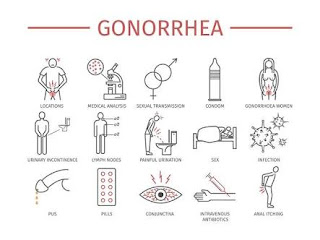Causes , Symptoms , And Treatment Of Gonorrhea
CAUSES , SYMPTOMS OF GONORRHEA
• Gonorrhea is caused by the bacterium
Neisseria gonorrhoeae .
• Gonorrhea can be passed from mother to
baby during delivery.
• Gonorrhea and chlamydia can be experienced
simultaneously.
• If untreated, gonorrhea can increase a
person's risk of acquiring or transmitting HIV
Gonorrhea is a common sexually transmitted
disease, sometimes referred to as "the clap." It
affects hundreds of thousands of men and
women annually in the United States.
Globally, there are an estimated 78 million new cases
of gonorrhea diagnosed each year. In the United
States alone, there are an estimated 820,000 new
gonorrhea infections each year. However, not all cases
are diagnosed and reported; only 333,004 cases of
gonorrhea were reported in the U.S. in 2013.
Gonorrhea is easily treated but can cause serious and
sometimes permanent complications.
Pelvic
inflammatory disease occurs in women when the
gonorrhea infection affects their uterus or fallopian
tubes. The most serious complication associated with
pelvic inflammatory disease is infertility.
Complications in men with gonorrhea include
epididymitis (an inflammation of the tube which
carries sperm) and infertility.
Symptoms of gonorrhea
Symptoms may be absent despite an active
gonorrheal infection. Symptoms can appear anywhere
from 1-14 days following exposure to the infection.
Men and women experience slightly different
symptoms; these can include:
Men:
white, yellow, or green urethral discharge,
resembling pus
pain in the testicles or scrotum
painful or frequent urination
anal discharge, itching, pain, bleeding, or pain
when passing stools
itching, difficulty swallowing, or swollen neck
lymph nodes
eye pain, light sensitivity, or eye discharge
resembling pus
red, swollen, warm, painful joints
Women:
painful sexual intercourse
fever
yellow or green vaginal discharge
vulvar swelling
bleeding in-between periods
heavier periods
bleeding after intercourse
vomiting and abdominal or pelvic pain
painful or frequent urination
anal discharge, itching, pain, bleeding, or pain
with passing bowel movements
sore throat , itching, difficulty swallowing, or
swollen neck lymph nodes
eye pain, light sensitivity, and eye discharge
resembling pus
red, swollen, warm, painful joints
Treatment for gonorrhea
Antibiotics forms part of the treatment of gonorrhea.
Upon displaying symptoms, a doctor may recommend
a test for gonorrhea in addition to other diseases.
Testing for gonorrhea can be completed by analyzing a
urine sample or a swab of an affected area. Swab
samples are commonly taken from the joystick, cervix,
urethra, anus, and throat.
Home kits for women are also available that include
vaginal swabs. These kits are sent to a laboratory and
results are reported directly to the patient.
If testing is positive for a gonorrhea infection, the
individual and their partner will need to undergo
treatment. This typically involves treatment.
Abstaining from sexual intercourse - until
treatment is complete, there is still a risk of
complications and spread of infection.
Repeat testing in some cases - it is not always
necessary to be tested to make sure the treatment
has worked. However, the CDC recommends
retesting for some patients, and a doctor will
decide if it is necessary. Retesting should be
performed 7 days after treatment.
If a woman is pregnant and infected with gonorrhea,
the infant will be given an eye ointment to prevent
gonorrhea transmission. However, antibiotics may be
required if an eye infection develops.
Causes of gonorrhea
There are an estimated 820,000 new gonorrhea
infections in the US each year.
Gonorrhea is an infection caused by the bacterium
Neisseria gonorrhoeae . It not only affects the
reproductive tract, but can also affect the mucous
membranes of the mouth, throat, eyes, and rectum.
The infection is transmitted through sexual contact
with an infected person involving the joystick, vagina,
anus, or mouth. Men do not need to ejaculate to
transmit or acquire gonorrhea.
Gonorrhea can also be passed from an infected mother
to her baby during delivery.
Although all sexually active individuals are at risk for
acquiring gonorrhea, the highest rates of infection
occur in teenagers, young adults, and African-
Americans.
Prevention of gonorrhea
There are many ways to prevent acquiring or passing
on gonorrhea; they include:
abstinence from sex
using condoms for sexual intercourse
using condoms or dental dams for oral intercourse
having sexual activity with a mutually
monogamous, unaffected partner
Individuals should speak with their doctor if they or
their sexual partner have been exposed to gonorrhea
or if they are experiencing any symptoms of infection.
Complications of gonorrhea
There are many serious potential complications,
which highlights the need for a quick diagnosis and
treatment if symptoms occur.
In women, gonorrhea can lead to:
pelvic inflammatory disease, a condition that can
cause abscesses
chronic pelvic pain
infertility
ectopic pregnancies - pregnancy where the
embryo attaches outside of the uterus
In men, a gonorrheal infection can lead to:
epididymitis - inflammation of the epididymis,
which controls the production of sperm
infertility
Both men and women are at risk of developing a life-
threatening disseminated gonococcal infection when
gonorrhea is untreated. This type of infection is often
characterized by:
fever
arthritis
tenosynovitis - inflammation and swelling around
tendons
dermatitis
Those infected with gonorrhea are also at a higher risk
of contracting HIV or, if already HIV positive, spreading
HIV in addition to gonorrhea.
Further complications of a gonorrheal infection can
occur in pregnant women during delivery; it is possible
to pass the infection to the child. Gonorrhea passed to
an infant can cause joint infection, blindness, or a life-
threatening blood infection.
Also, infected women are at an increased risk for
premature labor or stillbirth if left untreated.


Post a Comment